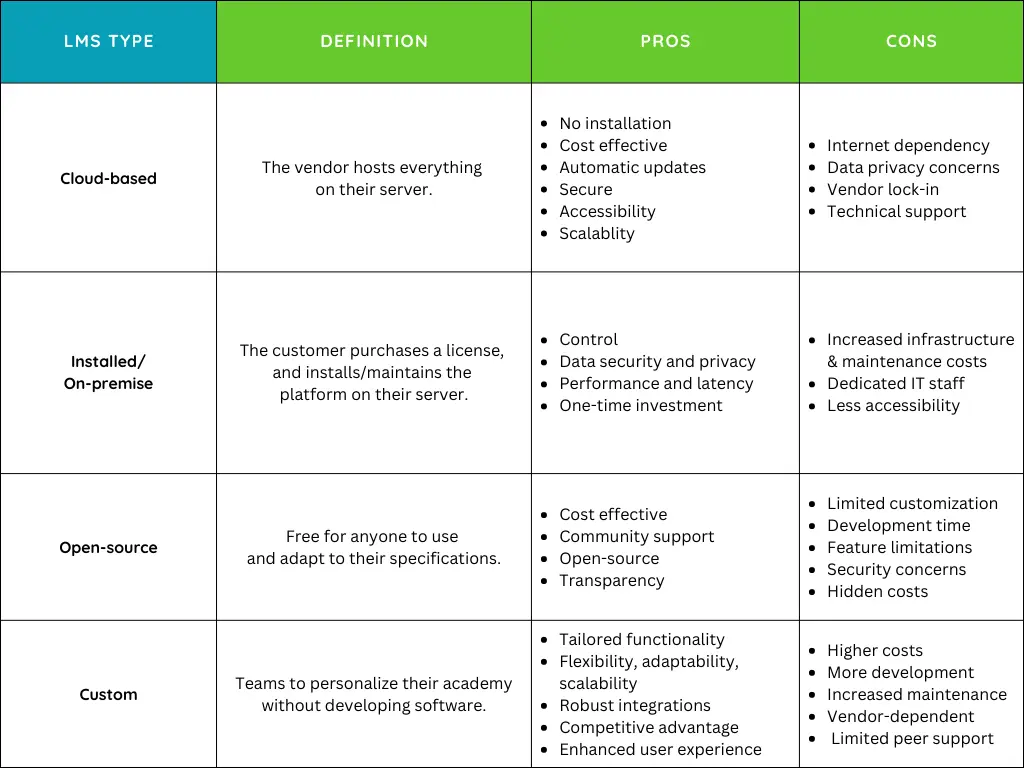What’s a Customer Education LMS?
A customer education LMS or customer training LMS is a software application for managing and delivering digital customer education programs. Customer education platforms help companies effectively and efficiently deliver the educational content their customers need to unlock their product or service’s full potential.
Types of Customer Education LMSs
There are a lot of customer education LMSs on the market today, but they’re not all the same. While many share features, there are distinct lines.
Custom-built LMS
A custom-built LMS gives you an enormous amount of control over the final outcome of the software. Since you’re having it custom-built from scratch, you can personalize the design to your exact specifications. However, the drawback is that building your own software from scratch is challenging, time-consuming and expensive, whether you do it in-house or outsource it to a developer.
SaaS LMS
A software as a service (SaaS) LMS is a bit like a cloud-based learning management system. It’s a customer education platform that another company has developed and hosts on their servers. By using a SaaS LMS, you can greatly reduce the time and resources required to create a customer education program because you don’t have to build your own software from scratch. Many SaaS customer education platforms are extremely customizable, allowing you to present a fully personalized interface to the user.
Installed LMS
An Installed LMS is an LMS that is hosted on your own servers instead of on a provider’s servers (like the SaaS LMS variety). This allows you greater control over aspects like data storage and security, but you’re also fully responsible for maintaining the data. As your data storage needs grow, it may become more trouble than it’s worth to handle it yourself.
Open-source LMS
An open-source LMS is built on open-source code that anyone can customize to suit their customer education needs. This can offer a great deal of flexibility without requiring you to build your own LMS completely from scratch, but you’ll still need access to some considerable coding abilities to personalize the platform for your brand.

Factors to Consider When Picking an LMS for Customer Education
How do you know which type of customer education LMS is best for your program? Here are a few factors to consider:
- Scale: How many customers will you be training with your LMS—now and in the future?
- Budget: How much budget do you have allocated for your customer education LMS? You should also look at budgeting from a resource perspective. How much time can you dedicate to the program? Do you have content creators in-house?
- Features: Do you need specific integrations with other systems, like your Customer Success Platform? Is advanced reporting essential?
- Technical Expertise: Some customer education learning management systems require a higher level of expertise, e.g., installed and custom. If you’re opting for one of those, having technical resources on hand will be critical.
- Customization: How much flexibility do you want over your academy’s design? If you want it to be a seamless extension of other brand touch points or embedded directly in your app, a custom LMS will likely be necessary.
- Support: Will you need support to scale your program? How important is having a Customer Success Manager and a robust knowledge base to your ultimate success?
At the end of the day, picking the LMS type that’s right for you comes down to budget and control.
What You Need to Know About Customer Education Learning Management Systems
A customer education learning management system (LMS) is a type of software that makes it easier for customer education teams to create, manage, and deliver educational content to their customers. (You might also hear people call it a customer education platform.) A customer education LMS is a kind of platform used to build an online learning environment that enables customers to succeed with your products and services.
There are numerous groups that can benefit from an LMS, including employees and partners. However, one of the most important groups to educate sufficiently is your customers. When your customers are well-educated about your products and services, you may see a variety of business gains, such as higher sales numbers, lower churn, fewer customer support expenses and more.
Building an extensive online customer education academy from scratch without an LMS is a challenging task. A customer education platform introduces all kinds of possibilities and makes the idea of developing a successful learning environment for customers seem more attainable.
Here are some examples of the LMS features that can make creating a customer education program a breeze:
- Customization: Many learning management systems are highly customizable, allowing you to tailor the user interface to provide whatever kind of customer experience you wish. For some platforms, this goes beyond simply changing colors and logos—you can truly personalize every aspect of your academy’s design.
- Learning Paths: Just like you can customize the appearance of your customer academy with an LMS, you can also personalize the learning experience for each customer. You can design learning paths to take customers through predetermined sequences of content to suit different needs.
- User Feedback: One of the most important steps of running a successful customer education program is collecting feedback from your users. This makes it possible to make incremental improvements to your customer education materials. You can use an LMS to deliver surveys or implement other customer feedback tools.
- Flexibility: Different people learn in different ways, so it’s best to incorporate multiple content formats into your customer education courses. This way, you can cater to a variety of learning styles. An LMS can be used to deliver multiple kinds of content such as videos, charts and graphs, infographics, quizzes and more. Plus, you can use an LMS to easily optimize content for mobile devices.
- Certifications: Certifications can be used to motivate learners to complete courses or learning paths. When your customers have a concrete goal to work toward, it can inspire them to see courses through to the end, improving your course completion rate. Certifications are also opportunities for professional development, which can entice learners to strive for them.
- Content Creation: A learning management system can do more than just deliver content. You can also use the tools that come with an LMS to create the content itself and upload it directly where your customers can benefit from it.
- Seamless Integration: One of the best parts of using a customer education platform is that it enables you to integrate your customer education with the rest of your tech stack. You can use APIs to allow your learning management system to communicate with your other systems for a seamless learning environment.
- Learner analytics: You can use a customer education platform to keep track of information regarding the way your customers are using your academy. This can help you determine whether they’re getting the most they could out of it or if there are areas that need to be improved. It can also help you tailor your content more closely to your customers’ needs.
Looking for a Top-class Customer Training LMS? Look no further.
Learn more about Gainsight Customer Education and download our LMS Buying Guide.
